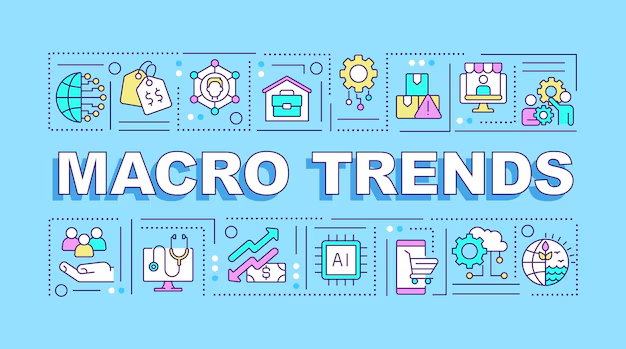Understanding Macrotrends: Insights and Implications for Business and Society

What are Macrotrends?
Macrotrends refer to significant, large-scale patterns or shifts that influence various aspects of society and the economy over an extended period. These phenomena typically emerge as gradual changes and highlight evolving societal behaviors, values, and preferences. Unlike microtrends, which are short-lived and often confined to specific segments of the market or demographic groups, macrotrends represent widespread movements that can reshape entire industries and influence global markets.
Characteristics of macrotrends include their longevity, widespread impact, and the ability to drive changes in policies, business strategies, and cultural paradigms. Macrotrends often unfold over years or decades and can arise from various factors, such as technological advancements, demographic shifts, economic conditions, and sociopolitical dynamics. For example, the increasing focus on sustainability and environmental consciousness has emerged as a macrotrend, compelling businesses to adopt greener practices and innovate eco-friendly products to cater to a more environmentally aware consumer base.
Understanding macrotrends is crucial for organizations aiming to remain relevant and competitive in today’s fast-paced world. By analyzing these larger patterns, businesses can identify opportunities for growth and innovation, anticipate market demands, and align their strategies accordingly. Furthermore, macrotrends offer insights into consumer behavior, informing businesses on how to adapt to changing preferences and expectations.
A good grasp of macrotrends allows companies to navigate the complexities of their operating environments effectively. The ability to discern and act upon these large-scale changes is essential not only for achieving business success but also for contributing positively to society as a whole. As businesses adapt to emerging macrotrends, they not only reshape their landscapes but also drive transformative changes across various sectors, creating a ripple effect that influences the broader economy and social fabric.
The Importance of Macrotrends in Today’s World
Macrotrends play a critical role in shaping both business strategy and public policy, serving as a lens through which organizations and governments can assess the broader shifts taking place in society. These large-scale trends encompass economic, technological, social, and environmental changes that can impact industries and economies on a global scale. Understanding macrotrends allows decision-makers to anticipate shifts in consumer behavior, regulatory environments, and competitive landscapes, thereby making informed strategic choices.
In the realm of business, recognizing prevailing macrotrends can help companies identify new market opportunities and adapt to changing consumer preferences effectively. For instance, the increasing emphasis on sustainability has driven many organizations to innovate their products and processes, aligning with environmental macrotrends. Companies that fail to heed these shifts may find themselves at a competitive disadvantage, as consumers increasingly prioritize brands that reflect their values concerning sustainability and social responsibility.
Moreover, macrotrends can create entirely new industries or transform existing ones. The rise of digital technology has significantly disrupted traditional sectors such as retail and communication, leading to the emergence of e-commerce and social media platforms. Businesses that proactively take note of technological advancements can leverage these shifts to enhance their efficiency and market positioning.
On a governmental level, macrotrends also inform policy-making by highlighting areas that require attention and investment. For example, demographic shifts such as aging populations or urbanization can influence resource allocation in healthcare and infrastructure development. Therefore, policymakers must stay abreast of macrotrends to craft regulations and initiatives that will be beneficial in the long term.
In sum, the significance of macrotrends cannot be overstated; they serve as essential tools for both businesses and governments. By acknowledging and adapting to these expansive trends, organizations can navigate the complexities of modern markets and contribute to informed decision-making processes that benefit society at large.
Identifying Macrotrends: Tools and Techniques
Identifying macrotrends is crucial for businesses and organizations aiming to adapt and thrive in an ever-evolving landscape. Various tools and techniques can facilitate this process, allowing decision-makers to make informed choices based on data-driven insights. One of the primary methods involves comprehensive data analysis, which leverages historical and current data points to uncover patterns that signal potential changes in market dynamics. Advanced analytical tools can parse through large datasets to identify correlations and anomalies, enabling businesses to pinpoint emerging macrotrends effectively.
Another valuable approach is conducting trend forecasting workshops that bring together experts and stakeholders from diverse fields. These collaborative sessions encourage brainstorming and interaction, allowing participants to share insights and perspectives that could reveal underlying macrotrends. By fostering a dialogue among industry leaders, organizations can harness collective knowledge and anticipate shifts in consumer preferences or technological developments that may influence future strategies.
Additionally, the use of social media analytics has emerged as a powerful technique for identifying macrotrends. Online platforms provide a wealth of real-time information, reflecting cultural and societal sentiments. By analyzing engagement metrics, topics of discussion, and demographic data, companies can gauge public interest in emerging issues or innovations. Monitoring these digital signals can serve as a precursor to larger shifts, enabling businesses to adapt proactively rather than reactively.
In conclusion, effectively identifying macrotrends requires a combination of data analysis, collaborative workshops, and social media monitoring. By employing these tools and techniques, organizations can enhance their ability to recognize and interpret emerging signals in culture, technology, and economics, positioning themselves favorably for the future. Understanding these macrotrends not only assists in strategic planning but also ensures adaptability in a rapidly changing world.
Key Macrotrends Shaping the Future
In today’s rapidly evolving landscape, several macrotrends are significantly influencing the trajectory of both business environments and societal norms. Understanding these trends is crucial for organizations seeking to align their strategies with future developments. Among the most impactful macrotrends are technological advancements, sustainability initiatives, demographic shifts, and changing consumer behaviors.
Technological advancements represent a major driving force in this modern era. Innovations in areas such as artificial intelligence, robotics, and the Internet of Things (IoT) are altering traditional business models and creating new market opportunities. Companies are increasingly leveraging these technologies to enhance efficiency, reduce costs, and improve customer experiences. As these advancements continue to evolve, organizations must adapt quickly to remain competitive in an increasingly digitized economy.
Sustainability is another vital macrotrend that is becoming increasingly prominent. As concerns about climate change and environmental degradation rise, businesses are under pressure to adopt sustainable practices. This shift is not only vital for compliance with regulations but also aligns with consumer expectations. Organizations prioritizing sustainability can gain a competitive edge by appealing to environmentally-conscious consumers and investors.
Demographic shifts, including aging populations and urbanization, are also shaping the future landscape. These changes influence labor markets, consumer demand, and economic growth. Companies must understand these demographic trends to effectively cater to diverse consumer bases and workforce compositions, ensuring they attract and retain talent across generations.
Lastly, changes in consumer behavior, accelerated by the digital age, are reshaping market dynamics. Consumers today demand personalized experiences, transparency, and ethical practices from businesses. Recognizing and adapting to these evolving preferences will be paramount for organizations aiming to thrive in the future marketplace.
Case Studies: Businesses Leveraging Macrotrends
In today’s rapidly evolving market landscape, various businesses have recognized the significance of macrotrends and have successfully harnessed them for their advancement. By identifying these macrotrends early, such enterprises have not only sustained their competitive edge but have also fostered innovation within their respective sectors. One notable example is Nike, which adapted its marketing strategies in response to the growing demand for sustainability. This macrotrend towards environmental consciousness prompted the company to launch its “Move to Zero” initiative, aiming for zero carbon emissions and zero waste. By embracing this trend, Nike not only enhanced its brand image but also attracted a customer base that values sustainability, ultimately resulting in increased sales and customer loyalty.
Another compelling case is that of Netflix, which transformed itself from a DVD rental service to a leading streaming platform. Recognizing the shift in consumer behavior towards on-demand content consumption, Netflix capitalized on this macrotrend by investing heavily in original programming and enhancing its streaming technology. This strategic pivot allowed the company to cater to the evolving preferences of users seeking convenience and variety, thereby setting the stage for their meteoric rise within the entertainment industry.
Similarly, Airbnb’s rise can be attributed to its adeptness in leveraging macrotrends such as the sharing economy and the desire for authentic travel experiences. By capitalizing on these trends, Airbnb created a platform that allowed individuals to monetize their spaces, thus unlocking new travel opportunities for consumers while fostering community connections. The company’s growth illustrates how understanding and integrating macrotrends into business strategy can lead to innovative solutions and market expansion.
Overall, the ability to recognize and adapt to macrotrends is crucial for businesses aiming for growth. The above examples serve as instructive case studies, demonstrating how strategic foresight and responsiveness to emerging trends can redefine industries and create lasting success.
The Risks of Ignoring Macrotrends
In today’s fast-paced business environment, adequately addressing macrotrends is crucial for an organization’s long-term success. Failing to recognize and adapt to these overarching trends can lead to significant repercussions, as many companies and industries have experienced in the past. Macrotrends, which encompass large-scale changes in economics, technology, demographics, and societal values, dictate the marketplace’s dynamics and consequently, the viability of businesses operating within it.
One notable example is Kodak, a company that once dominated the photography industry. Despite being a pioneer in digital imaging technology, Kodak failed to pivot from its traditional film-based business model in response to the rising macrotrend of digital photography. As consumer preferences quickly shifted toward digital solutions, Kodak’s inability to adapt ultimately led to its bankruptcy in 2012. This incident exemplifies how overlooking significant macrotrends can be detrimental to a company’s prospects.
Furthermore, the retail industry has also seen major shifts due to macroeconomics and technological advancement. Companies like Blockbuster overlooked the changing landscape of home entertainment, where streaming services began to dominate consumer preferences. By ignoring the macrotrend toward digital content consumption, Blockbuster missed the opportunity to innovate and diversify its services, resulting in a sharp decline in market presence and eventual closure.
Such examples underscore that businesses need a proactive approach to engage with macrotrends. Staying aware of emerging patterns and adjusting strategic goals accordingly not only safeguards an organization’s relevance but also enhances its competitive edge. Moreover, the continuous analysis of macrotrends empowers companies to make informed decisions that can mitigate risks associated with sudden market shifts. Ultimately, those who choose to ignore these trends do so at their own peril, threatening not only their market position but also their long-term sustainability.
How Businesses Can Prepare for Future Macrotrends
In an ever-changing economic landscape, businesses must proactively prepare for macrotrends to remain competitive and relevant. Adapting to these overarching shifts requires a multifaceted approach involving agility in strategy formulation, continuous learning, and strategic investment in research and development.
Agility in strategy formulation is crucial for organizations aiming to navigate the dynamic nature of macrotrends effectively. Companies should foster a culture that encourages flexibility and responsiveness, allowing them to pivot quickly when emerging trends become evident. This could involve implementing agile methodologies that enable rapid project adjustments based on newly available data or developments in consumer behavior. By remaining flexible, businesses can capitalize on opportunities presented by these larger societal shifts while mitigating potential risks associated with stagnation.
Continuous learning and adaptation must be prioritized as part of a long-term strategy to confront macrotrends. Organizations should invest in training programs that equip employees with the skills needed to understand and respond to changing market conditions. This includes fostering a mindset of curiosity and encouraging employees to engage in lifelong learning. Additionally, businesses could establish cross-functional teams that combine various expertise to address complex issues arising from macrotrends, promoting innovation and diverse problem-solving strategies.
Moreover, investing in research and development (R&D) is vital for staying ahead of emerging trends. Organizations should allocate resources towards exploring new technologies, consumer needs, and market demands. By aligning R&D initiatives with anticipated macrotrends, businesses can develop products and services that not only meet current demands but also anticipate future changes in the market landscape.
In conclusion, preparing for future macrotrends requires a structured approach that emphasizes agility, continuous learning, and strategic investment in R&D. By adopting these strategies, businesses can enhance their resilience and adaptability in the face of inevitable societal changes, positioning themselves for sustained growth and success.
Macrotrends and Global Challenges
Macrotrends are long-term shifts that shape societies and economies, influencing every aspect of life from consumer behavior to policy decisions. As the world grapples with systemic issues such as climate change, inequality, and public health crises, understanding the interaction between these macrotrends and global challenges is crucial for fostering effective solutions. By analyzing these trends, businesses and policymakers can identify emerging patterns that dictate the direction of societal needs and environmental impact.
Climate change presents a pressing global challenge that has drawn attention to the interconnectedness of human activities and environmental sustainability. Macrotrends related to renewable energy adoption, urbanization, and environmental consciousness are altering consumer expectations and prompting businesses to innovate sustainably. Companies that align their strategies with these macrotrends are not only enhancing their reputational capital but are also contributing to broader ecological goals. For policymakers, the challenge lies in crafting regulations and incentives that encourage businesses to transition to more sustainable practices, thus facilitating a comprehensive response to climate change.
Inequality is another significant global challenge, with macrotrends highlighting disparities in wealth and access to resources. The rise of the digital economy has created new opportunities; however, it has also exacerbated existing inequalities. Businesses must adapt to this reality by embracing corporate social responsibility and ensuring their practices contribute to equitable growth. Policymakers play a vital role in establishing frameworks that empower marginalized communities, facilitating a more inclusive economic structure.
Finally, public health crises, as evidenced by the recent pandemic, underscore the critical nature of macrotrends in shaping healthcare systems. Shifts in demographic trends and technology adoption are influencing patient care and safety protocols. Responses to such challenges demand cohesive strategies from both businesses and governments, ensuring that health outcomes ultimately align with societal well-being. By understanding macrotrends, stakeholders can forge pathways to resolve these pressing challenges while promoting long-term resilience.
Conclusion
As we navigate the complexities of an increasingly interconnected and dynamic world, the significance of understanding macrotrends cannot be overstated. These large-scale shifts provide invaluable insights that shape not only business strategies but also societal frameworks. Organizations that proactively embrace macrotrends are better equipped to adapt to changes, anticipate future developments, and maintain a competitive edge. It is essential for business leaders and decision-makers to recognize the fluid nature of these trends, which encompass economic, social, technological, and environmental dimensions.
Adapting to macrotrends requires a keen sense of foresight and an understanding of the underlying forces driving change. Companies must establish robust monitoring systems to identify emerging trends relevant to their industries. By using data analytics and research, businesses can interpret these trends to inform strategic planning and operational adjustments. This proactive approach will foster resilience and innovation, enabling organizations to respond effectively to shifting consumer preferences and market demands.
Moreover, staying engaged with macrotrends is critical for societal development. Communities and policymakers must be aware of these trends to align their initiatives with present and future needs. By fostering a collaborative environment that emphasizes adaptability and responsiveness, societies can harness macrotrends to create sustainable growth and improved living standards. As individuals, it is also vital to remain informed about these macrotrends, contributing to a more holistic understanding of our global context.
In conclusion, embracing macrotrends not only positions businesses and society for greater success but also promotes a proactive stance toward future challenges and opportunities. Adapting to this ever-evolving landscape will ultimately yield a better and more sustainable future for all stakeholders involved.
You May Also Read This Digitalcompound.



